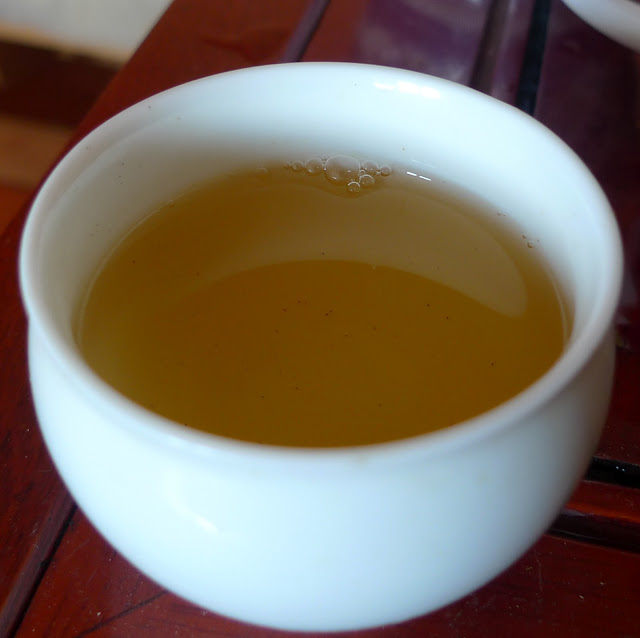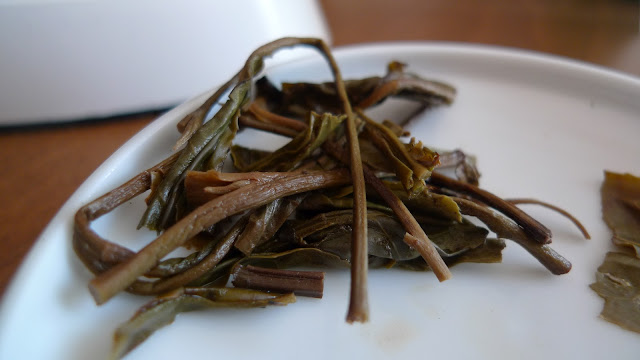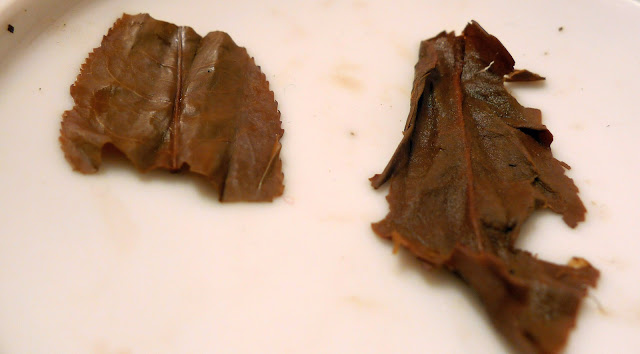*) Ouch, I realized that I use "tea" and "puerh" almost interchangeably... I mean mostly puerh here.
My proposition is: "Tea can be rated objectively, but there is little point in doing so", i.e., there are some parts of tea evaluation, which are objective, but the interpretation of the measurement and more things that I consider important are sort of subjective.
You can objectively judge the origins of tea - where it comes from, which cultivar it is made of, how large the leaves are, how processed they are, how damaged they are. Of course, the resulting liquor may be measured chemically, but what does it tell us? Lending an example from the world of wine, many Chateauneuf du Pape wines are really densely sweet...yet there is no sugar present (all used in the fermentation process). So if we measure that there is no sugar, what do we know? Well...that there is no sugar. Awesome.
Another objective measures could be creation of histograms of photos of wet leaves, telling us, whether the leaves are aging consistently, etc.
Another possible measure is measurement of the source tree - its age, for exampe. It it really such a good measure? Are todays ancient trees good because they are simply good, or because they are not as massively raped as poor plantation teas? I think it is the latter case (and, as I have been given to understand, it is changing too). I've had several very good plantation teas and some exceptionally boring old trees (or exceptionally unpleasantly bitter wild trees). So, we may, again, measure the source tree, but what does it tell us?
I think that the objective part is awesome for tea merchants and investors - you measure all that and can happily say "my tea is a high quality one", period. They don't have to understand the tea that much, they may concentrate on buying and selling.
To the subjective part - I'll run through the checkpoints I usually observe in tea:
- Dry leaves appearance and smell - I mostly do not pay that much attention to these. There is a fashion of huge, whole leaves, but I have some doubts whether it is good or not. I feel that a lot of teas from 2003-2007 which were composed of such "beautiful" leaves were heading to the realm of Too subtle and light. I am not saying a tea should be powdered or anything like that, but teas that I consider to be "standard-style" and "aging well", e.g., Haiwan Pa Sha 2006 or Boyou Manlu 2007 are not anything super-awesome, judged by today's standards of the beauty of leaves.
- Wet leaves appearance and smell - I enjoy these a lot, especially the aroma. It tells a lot about what is going on in the tea beyond taste. But I don't see what there is to rate.
- Taste of the liquor - this is a big topic. In wine, there are some "objective" standards, but with all the respect I have towards wine, I think that puerh has more dimensions to it. And the world of french wine is quite orderly too, much more than the world of puerh.
The issue is that people have different taste buds and will perceive/enjoy tastes differently. Also, a huge factor is the amount of training one has. When I was at my 10th puerh, it was like "hmm, not bad, but these puerh teas are quite similar to each other" - and now, puerh seems like a huge and intricate world to me. I.e., rating taste objectively would be weird because it would be highly dependent on the taster, thus being hardly objective. - Aftertaste - again, people with little experience will not notice it as cleanly as more experienced drinker.
- Mouthfeel - even more extreme case of the previous point. When I sometimes offer puerh from old trees to non-puerh drinkers, they generally do not notice the strong cooling and tingling sensation at all. Puerh drinkers do.
- Cha qi - that is such a subtle and personal topic (yet a crucial one, especially in aged tea) that I would not even try to make an attempt at objective rating.
- Quality now/in future - what is a "great tea"? Why to invest huge money ($100-200 a cake) into premium 2011-12 teas, when you can get really good mid-aged tea from 2001-3 for that money? These mid-aged teas are already nicely aging, often being at the peak of their taste potential. And, for me, they are ten times more enjoyable than the "potentially awesome" young teas. So, if we wanted to rate a tea objectively, what would we do with the rating of its potential? The potential for further development is a crucial feature, but it does not make a tea good now.
- Aging - if you "rate Xiaguan 8653 from 80s", what do you actually rate? Try the two differently stored versions from EoT (if they are restocked) and tell me if you would think it is the originally same tea.
There are other, general matters - water quality for example. Some teas are good with filtered water, some are better with unfiltered, some are better when in brewed silver, some when brewed in iron. You could go on like that for many lines.
Then, how about the brewing skill? Getting back to the 2006 Haiwan Pa Sha (or 2010 YS Purple tea), these show how important brewing skill is. When brewed "normally", they are okay, but hardly super-awesome. But once one learns how to prepare them, they can get really great. It is a contrast to, e.g., 2009 HLH Yiwuzhengshanor 2008 Menghai Star of Bulang, which is not that sensitive to preparation.
I think that the most difficult part is the experience of the drinker really... and that the part is such an important one that it makes objective rating quite meaningless. I hear mostly merchants promoting the objective rating - I wonder if there is anything beyond washing hands off unhappy customers.
















































